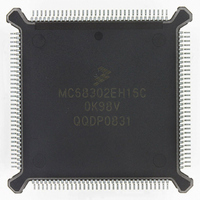MC68302EH16C Freescale Semiconductor, MC68302EH16C Datasheet - Page 418

MC68302EH16C
Manufacturer Part Number
MC68302EH16C
Description
IC MPU MULTI-PROTOCOL 132-PQFP
Manufacturer
Freescale Semiconductor
Datasheets
1.MC68302AG20C.pdf
(4 pages)
2.MC68302AG20C.pdf
(2 pages)
3.MC68302AG20C.pdf
(13 pages)
4.MC68302EH16C.pdf
(481 pages)
Specifications of MC68302EH16C
Processor Type
M683xx 32-Bit
Speed
16MHz
Voltage
5V
Mounting Type
Surface Mount
Package / Case
132-MQFP, 132-PQFP
Controller Family/series
68K
Core Size
32 Bit
Ram Memory Size
1152Byte
Cpu Speed
16MHz
No. Of Timers
3
Embedded Interface Type
SCP, TDM
Digital Ic Case Style
PQFP
Rohs Compliant
Yes
Family Name
M68000
Device Core
ColdFire
Device Core Size
32b
Frequency (max)
16MHz
Instruction Set Architecture
RISC
Supply Voltage 1 (typ)
5V
Operating Temp Range
0C to 70C
Operating Temperature Classification
Commercial
Mounting
Surface Mount
Pin Count
132
Package Type
PQFP
Lead Free Status / RoHS Status
Lead free / RoHS Compliant
Features
-
Lead Free Status / Rohs Status
RoHS Compliant part
Electrostatic Device
Available stocks
Company
Part Number
Manufacturer
Quantity
Price
Company:
Part Number:
MC68302EH16C
Manufacturer:
Freescale Semiconductor
Quantity:
135
Company:
Part Number:
MC68302EH16C
Manufacturer:
PANA
Quantity:
99
Company:
Part Number:
MC68302EH16C
Manufacturer:
Freescale Semiconductor
Quantity:
10 000
Part Number:
MC68302EH16C
Manufacturer:
FREESCALE
Quantity:
20 000
Company:
Part Number:
MC68302EH16CB1
Manufacturer:
Freescale Semiconductor
Quantity:
10 000
Company:
Part Number:
MC68302EH16CR2
Manufacturer:
Freescale Semiconductor
Quantity:
10 000
- MC68302AG20C PDF datasheet
- MC68302AG20C PDF datasheet #2
- MC68302AG20C PDF datasheet #3
- MC68302EH16C PDF datasheet #4
- Current page: 418 of 481
- Download datasheet (2Mb)
MC68302 Applications
A synchronous UART built with transparent mode has one simplifying difference from a 5-
or 6-bit UART. Since a clock is provided with each bit, the transparent mode can be clocked
at 1x the data rate, reducing the transparent bandwidth and the buffer memory require-
ments. The only disadvantage is that the M68000 core must build the transmit buffer up a
bit at a time using bit instructions.
D.8.13 SCP as a Transparent Mode Alternative
One often overlooked feature of the MC68302 is the SCP. If your application needs byte-at-
a-time transparent mode operation, the SCP may fit the bill. The SCP, a subset of the Mo-
torola synchronous SPI protocol interface, transmits and receives bytes in a transparent
mode.
Each time the M68000 core sets the start bit in the SCP, one byte of data is shifted from the
SCP buffer descriptor out on the SPTXD pin (see Figure D-31). At the same time that trans-
mit data is being clocked out, receive data is being clocked into the MC68302.
The advantages of using the SCP instead of an SCC in transparent mode are simplicity and
the saving of SCCs for other functions. There are two disadvantages, however. First, the
M68000 core must be individually involved in each byte transferred (an interrupt may be
generated per byte); thus, data cannot be sent back-to-back without at least some delay.
Second, the SCP functions in a clock master mode only; therefore, the device communicat-
ing with the SCP must be able to accept an external input clock.
It is possible for the SCP to interface externally to one of the MC68302's SCCs. For instance,
this type interface could be used to convert HDLC-encoded data from a serial format to a
parallel format so that it can be moved over the M68000 bus.
D.8.14 Transparent Mode Summary
The totally transparent mode on the MC68302 can be used in many ways. Once the desired
physical interface is chosen (NSMI, PCM, IDL, or GCI), the vast number of possibilities can
begin to be narrowed down. These possibilities were described in D.8 Using the MC68302
Transparent Mode, with emphasis on the NMSI and PCM modes. A step-by-step register
initialization was given for a transparent loopback application on SCC2. It was also stated
that occasionally BISYNC mode can be used in place of an SCC in transparent mode.
D-68
MC68302 USER’S MANUAL
MOTOROLA
Related parts for MC68302EH16C
Image
Part Number
Description
Manufacturer
Datasheet
Request
R
Part Number:
Description:
Manufacturer:
Freescale Semiconductor, Inc
Datasheet:

Part Number:
Description:
MC68302 Configuring the Chip Selects on the MC68302
Manufacturer:
Motorola / Freescale Semiconductor

Part Number:
Description:
MC68302 Design Concept - Expanding Interrupts on the MC68302
Manufacturer:
Motorola / Freescale Semiconductor

Part Number:
Description:
MC68302 MC68302 Adapting a WAN Controller to a LAN Environment
Manufacturer:
Motorola / Freescale Semiconductor

Part Number:
Description:
MC68302 EKB Applications - Power Measurements on the MC68302
Manufacturer:
Motorola / Freescale Semiconductor

Part Number:
Description:
MC68302 Interfacing the MC68020 to a Slave MC68302
Manufacturer:
Motorola / Freescale Semiconductor

Part Number:
Description:
MC68302 MC68302 Software Performance
Manufacturer:
Motorola / Freescale Semiconductor

Part Number:
Description:
MC68302 Evaluating EDX on the ADS302
Manufacturer:
Motorola / Freescale Semiconductor

Part Number:
Description:
MC68302 Design Advisory #1 - MC68SC302 Passive ISDN Protocol Engine
Manufacturer:
Motorola / Freescale Semiconductor

Part Number:
Description:
MC68302, MC68360, and MPC860 Characteristics and Design Notes for Crystal Feedback Oscillators
Manufacturer:
Motorola / Freescale Semiconductor
Part Number:
Description:
Mc68302 Integrated Multi-protocol Processor
Manufacturer:
Freescale Semiconductor, Inc
Datasheet:
Part Number:
Description:
Manufacturer:
Freescale Semiconductor, Inc
Datasheet:
Part Number:
Description:
Manufacturer:
Freescale Semiconductor, Inc
Datasheet:
Part Number:
Description:
Manufacturer:
Freescale Semiconductor, Inc
Datasheet:
Part Number:
Description:
Manufacturer:
Freescale Semiconductor, Inc
Datasheet:











